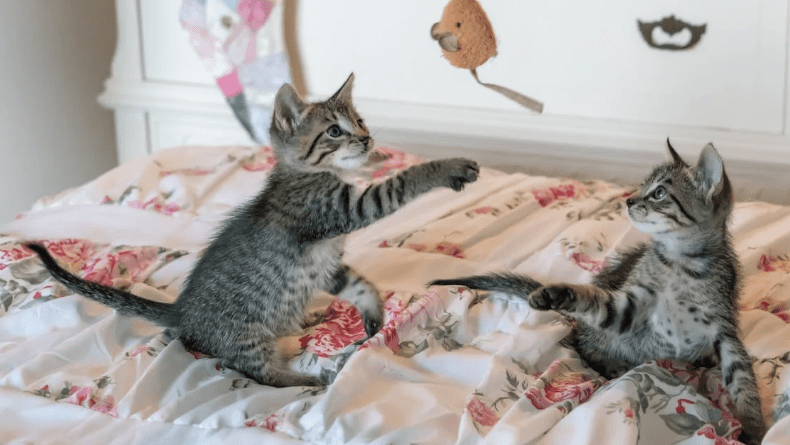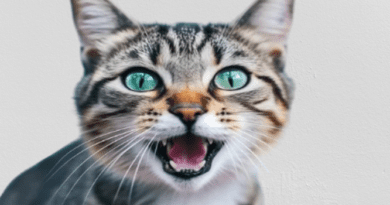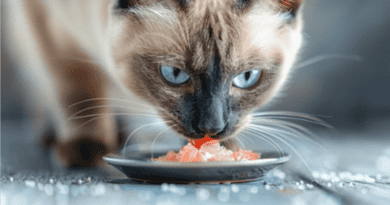Play Behavior in Cats
Play is a vital aspect of a cat’s life, reflecting their natural hunting instincts and contributing to their overall well-being. Even domesticated cats, which may never need to hunt for food, display behaviors that mimic the hunting process during play. This section explores how hunting instincts shape play behavior, the types of toys that cats prefer, and how play aggression can arise in certain situations.
Hunting Instincts in Play
At the heart of every playful pounce and chase lies a cat’s deep-rooted hunting instincts. Even though many cats receive food from their human companions, they are natural-born hunters, and play provides an outlet for these instincts. From the moment they are kittens, cats exhibit behaviors that mirror hunting in the wild—stalking, pouncing, and biting.
During play, you might notice your cat fixating on a moving object before crouching low and preparing to leap. This behavior closely resembles how a cat would approach prey. By engaging in this type of play, cats not only satisfy their natural urges but also keep their muscles toned and their minds sharp.
In multi-cat households, this hunting play sometimes extends to interactions between cats. Cats may chase each other around the house, swatting and pouncing, practicing their skills in a safe and controlled environment. However, it’s important to recognize when play becomes too aggressive, which we will explore later in this article.
Types of Toys Cats Prefer
The types of toys that attract a cat’s interest usually simulate the movements and textures of prey. Most cats love toys that move unpredictably, triggering their instinct to chase and capture. Here are some popular toys and why cats love them:
- Wand Toys: These toys have a string or a ribbon attached to a stick, with feathers or small objects dangling at the end. The flicking and fluttering motion mimics the erratic movements of birds or small animals. Cats find this irresistible, often jumping or chasing after the toy with gusto.
- Balls or Rolling Toys: Cats enjoy batting lightweight balls or rolling toys around the house, as it reminds them of chasing small prey like mice or insects. The way these toys bounce or roll unpredictably engages their minds and keeps them entertained for long periods.
- Interactive Puzzle Toys: Toys that dispense treats or require problem-solving engage a cat’s brain while satisfying their natural curiosity. Puzzle toys often have small compartments or openings that cats can manipulate to get a reward, simulating the process of hunting and foraging for food.
- Plush Toys: Cats may enjoy carrying or “killing” soft, plush toys by biting and kicking them with their back legs. This behavior mimics the action of capturing and subduing prey. Some cats even bring these toys to their human companions as if they were offering a successful hunt.
It’s important to rotate toys regularly to keep a cat’s interest. Offering a variety of textures, shapes, and movements will prevent boredom and provide both physical and mental stimulation.
Play Aggression
While play is essential for a cat’s development and happiness, it can sometimes lead to play aggression. Play aggression occurs when a cat becomes overly excited during play and may bite, scratch, or swat too hard. This behavior often stems from the cat’s hunting instincts, as they may not always differentiate between play and real prey.
Young cats and kittens are especially prone to play aggression, as they are still learning the boundaries of appropriate play behavior. During a hunting or play session, a kitten may pounce on a human’s hand or leg, mistaking it for prey. If this behavior isn’t corrected early on, it can become more problematic as the cat grows stronger and more agile.
To manage play aggression, consider the following tips:
- Use Toys, Not Hands: When playing with your cat, always use a toy instead of your hands. If your cat learns to associate hands with toys, they may develop the habit of swatting or biting during playtime. Wand toys or long strings are excellent for maintaining distance while allowing the cat to chase and pounce without targeting your body.
- Recognize Overstimulation: Pay attention to your cat’s body language during play. Dilated pupils, a twitching tail, or flattened ears can indicate overstimulation or excitement. If you notice these signs, it may be time to end the play session to prevent the cat from becoming too aggressive.
- Offer a Variety of Play Styles: Cats have different preferences when it comes to play. Some may prefer chasing toys, while others enjoy interactive puzzle games. Offering a range of play options can help productively channel their energy, reducing the likelihood of aggressive outbursts.
By providing proper outlets for play and recognizing the triggers for aggressive behavior, you can ensure that playtime remains a positive and enjoyable experience for both you and your cat.
Play is not only a source of entertainment for cats but also an essential part of their development, helping them express their natural hunting instincts in a safe environment. Understanding your cat’s play preferences and managing any signs of play aggression will lead to a more harmonious relationship. Whether it’s pouncing on a feather toy or batting a ball across the floor, cats thrive on the physical and mental stimulation that play provides.




